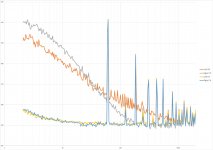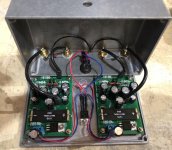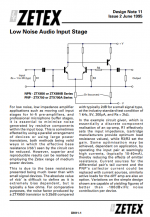First Sound test performed between the two contenders, after having checked the volume produced by Voltage and Current modules to be within 0.2dB with a 1Khz test tone.
Listened with two people. We both were a bit surprised by the relatively differences.
This must all be seen with the restriction that my listening tests have no general value, but are just valid in case of using a Benz LP Cart and Quad ESL speakers.
Not still sure if one betters the other, but first impressions were:
Current Amp: more low end, voices a bit warmer, maybe sounding a bit more life like , but less overall depth and width, as if you are sitting closer to the podium.
Voltage Amp: Wider stereo image, a bit sharper in the high frequencies and less bass, but nevertheless very involving, as if listening from a larger distance.
Will take more time to listen this week and to let my brains get used to the different sound, and hope to give my final judgement this weekend.
So far an interesting exercise.
Hans
Listened with two people. We both were a bit surprised by the relatively differences.
This must all be seen with the restriction that my listening tests have no general value, but are just valid in case of using a Benz LP Cart and Quad ESL speakers.
Not still sure if one betters the other, but first impressions were:
Current Amp: more low end, voices a bit warmer, maybe sounding a bit more life like , but less overall depth and width, as if you are sitting closer to the podium.
Voltage Amp: Wider stereo image, a bit sharper in the high frequencies and less bass, but nevertheless very involving, as if listening from a larger distance.
Will take more time to listen this week and to let my brains get used to the different sound, and hope to give my final judgement this weekend.
So far an interesting exercise.
Hans
The coil is shorten in current feedback. It. Get more stiff regarding movement in the track. So fast movement in the track would be damped.. That is my first thought.
Been all the time. Just like when you shorten a winding on a motor to break. Slow movement on a motor would not mean any resistance but fast would...
Been all the time. Just like when you shorten a winding on a motor to break. Slow movement on a motor would not mean any resistance but fast would...
Sadly coil damping is another urban legend. George measured it.

I am not sure what you are trying to say there, but I there is zero evidence of any magic from a current mode operation vs voltage mode for MC. The generators are just too inefficient for that. For MM there are some interesting possibilities but it turns out to only work for one or two cartridges.
I will consider doing this at a later stage, but first of all I want to do some more listening.Hans, can you digitize the same track with both amps and then apply diffmaker?
One thing that came to mind, the Current Amp is inverting and the Voltage Amp isn’t.
To adjust this, I will make them both non inverting.
Hans
Sadly coil damping is another urban legend. George measured it.
I think to be more careful, its been shown that the mechanical damping completely dominates any electromagnetic braking. And not unexpected if you think about the thing - the mechanical elements are carefully designed not to be resonant and should therefore be close to critical damped in a good cartridge, and the magnetic circuit has significant gaps so cannot be very efficient.
Sorry Mark, I don't agree with that. No evidence has been presented to support electromagnetic braking. And people on here have really tried with some serious levels driven into the cartridge.
And the mechanical system IS resonant. It has to be. It is damped, but the resonance is a good decade (or several) above where the damping is highest in many cases.
And the mechanical system IS resonant. It has to be. It is damped, but the resonance is a good decade (or several) above where the damping is highest in many cases.
If the short is the same. For voltage and current... Lets say 12.5ohm.. (~1mA emitter current 2x parallel)
Then there is no difference.. I totally agree... And you should not be able to hear any difference and even if the channel is inverting. (both channel in phase of course)
Then there is no difference.. I totally agree... And you should not be able to hear any difference and even if the channel is inverting. (both channel in phase of course)
Sutherland Engineering Little Loco phono preamplifier | Stereophile.com
Another nearly $4000 current mode phono stage! I note he puts the active components on the underside of the board so you can't see how simple it is
Another nearly $4000 current mode phono stage! I note he puts the active components on the underside of the board so you can't see how simple it is
hey at least he has gone SMT other than the goofy great load resistors which kind of scream 'no you don't want to change gain'. Does seem pricey when a parasound JC3+ is a grand less, and even that is £2500 more than I would proabably spend on phono stages... Although the parts budget is stacking up.
I should note here I do not think Ron is a bad guy. And he has chosen a hard way to pay the bills.
I should note here I do not think Ron is a bad guy. And he has chosen a hard way to pay the bills.
I was wrong
Indeed, the Aluminum Polymer caps are worse than regular, good quality electrolytics.
I took a #375, installed sockets for the 7 caps and swapped lots of Al polymer and electrolytics, measured the noise input shorted. Attached is the result, the regular electrolytics (type below) and the worst of the Al polymer devices I was able to get. These Al polymer are all over the place regarding noise (both in noise level and corner frequency), they can be as good as the regular electrolytics, but are certainly much worse on average.
Fortunately regular Panasonic electrolytics are available to replace directly the Al polymer in the $375 layout:
4xdecoupling: 3300uF/6.3V ECA-0JHG332 DigiKey P5511-ND
1xpower supply: 2200uF/6.3V ECA-0JHG222 DigiKey P5510-ND
2xoutput 1000uF/6.3V ECA-0JHG102 DigiKey P5509-ND
However, this is an interesting engineering exercise only, the excess LF noise was not audible (I tried hard).
The ZTX devices have a noise corner frequency around 12-15Hz, which makes sense.
With the Panasonic electrolytics, the noise of #375 (input shorted) is around 0.3nV/rtHz, down to 20Hz.
Indeed, the Aluminum Polymer caps are worse than regular, good quality electrolytics.
I took a #375, installed sockets for the 7 caps and swapped lots of Al polymer and electrolytics, measured the noise input shorted. Attached is the result, the regular electrolytics (type below) and the worst of the Al polymer devices I was able to get. These Al polymer are all over the place regarding noise (both in noise level and corner frequency), they can be as good as the regular electrolytics, but are certainly much worse on average.
Fortunately regular Panasonic electrolytics are available to replace directly the Al polymer in the $375 layout:
4xdecoupling: 3300uF/6.3V ECA-0JHG332 DigiKey P5511-ND
1xpower supply: 2200uF/6.3V ECA-0JHG222 DigiKey P5510-ND
2xoutput 1000uF/6.3V ECA-0JHG102 DigiKey P5509-ND
However, this is an interesting engineering exercise only, the excess LF noise was not audible (I tried hard).
The ZTX devices have a noise corner frequency around 12-15Hz, which makes sense.
With the Panasonic electrolytics, the noise of #375 (input shorted) is around 0.3nV/rtHz, down to 20Hz.
Attachments
Last edited:
However, this is an interesting engineering exercise only, the excess LF noise was not audible (I tried hard).
.
Surely that sums up this entire thread
It was Horowitz and Hill who shined a spotlight on the very low measured noise of the Zetex transistors. Zetex themselves, and their new corporate owners (Diodes Inc) just call it a medium power high current transistor. There's no mention of noise anywhere on the datasheet. There's no guarantee its noise will be the same from unit to unit, or from week to week, or from fab to fab.
Skiers who venture "off piste", away from the marked trails, are on their own.
Medical doctors who prescribe medications "off label", to treat conditions other than the ones the FDA has approved the drug for, are similarly on their own.
It may also be true that designers who use a transistor (or its vendor supplied .MODEL) "off datasheet", are similarly their own.
For a larruping good time, telephone Zetex's application engineers and ask them for a better SPICE model which is less inaccurate when modeling noise. Expect to be asked about the volume of Zetex parts you have purchased this year & will purchase next year. That's how they prioritize their time.
H&H may have widely publicised the low-noise performance of some of the Zetex transistors, but the firm have tried to draw attention to it, at least in their home territory (here in the UK) for many years. The attached Design Note on Moving Coil amplifiers is from their Application Book in the 1990s. Note in particular the adjective 'reproducible' on low Rbb.
The Zetex medium power transistors have low Rbb by design, and actually they have been remarkably consistent over decades of production. I suppose that Diodes could radically change the process to suit another fab, but the designs as they are give outstanding combinations of high Hfe and saturation performance at high current, and if they spoil this, the relatively high price points of Zetex parts would no longer be tolerated.
It's not just the types tested by H&H that have super low noise - many parts in the 7-series (ZTX7xx and FZT7xx) PNP and 6-series NPN have good performance too.
I can't speak for the Zetex that is now run by Diodes, Inc., but I can say that the Ferranti (who designed the first ZTXs) of the 1980s and Zetex PLC of the 1990s had staff who were remarkably helpful, and I learned many arcane points about transistors from them.
I liked the old firm so much at that time that I designed a CCFL backlight converter for our Handheld PCs with and all-Zetex semiconductor BoM, as a tribute.
Attachments
I will be interested to see if you leave the head amp in there after the tests...
Overload margin of my MC phonoamp is 30dB over the audio frequency range.
This is now reduced by 15dB with the inserted Head Amp.
Not sure if this step back is something to disregard.
Hans
Note in particular the adjective 'reproducible' on low Rbb.
Rbb is always reproducible; for a switching transistor, the designer tries to keep Rbb as low as possible, to minimize the saturation voltage. The price for having low Rbb is in general lower beta, at least in a standard process. Zetex found a sweet spot between saturation voltage and beta, with low noise as a byproduct.
There are essentially 3 noise sources in a bipolar device, Rbb, the collector current noise (or base, if you prefer SQRT(2qIb)) and the excess (shot, flicker, telegraph, GR) noise. The last component is LF and each excess noise generation mechanism is characterized by a coefficient, a power exponent for frequency, or the noise corner frequency, if you prefer. Physically, these excess noise sources are essentially determined by the manufacturing process cleanliness. Change the fab and the LF excess noise may blow the device noise performance off the chart, and that with a no (or minimum) impact on the switching device data sheet performance.
- Home
- Source & Line
- Analogue Source
- Richard Lee's Ultra low Noise MC Head Amp


